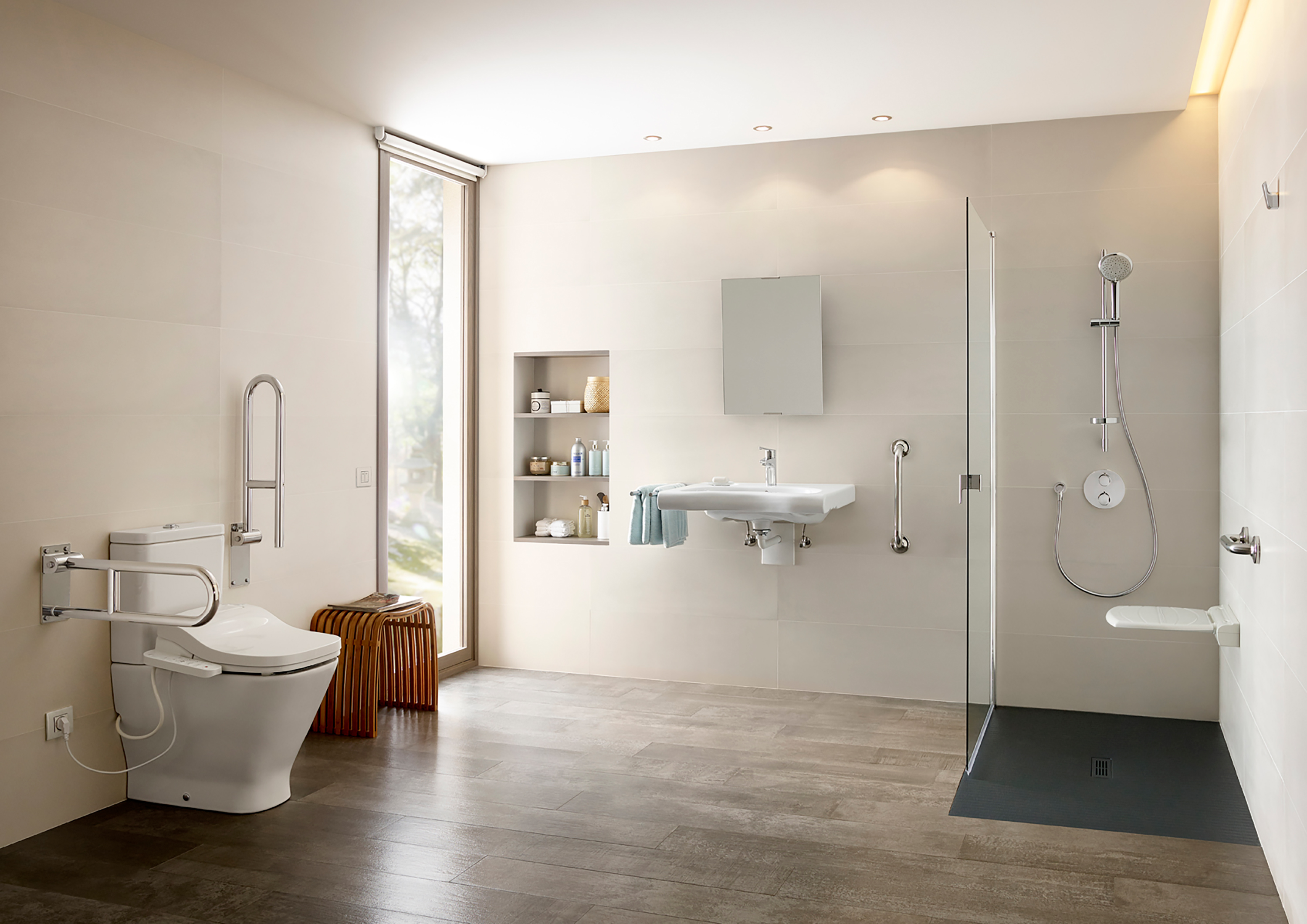Safety and Accessibility Features: Senior Friendly Bathroom Designs

A bathroom designed with seniors in mind should prioritize safety and accessibility, making it a comfortable and secure space for daily activities.
Non-Slip Flooring and Grab Bars
Non-slip flooring and strategically placed grab bars are essential for preventing falls and maintaining balance.
- Non-slip flooring materials like textured tiles or rubber mats can significantly reduce the risk of slips and falls, especially when the floor is wet.
- Grab bars installed near the toilet, shower, and bathtub provide additional support and stability, allowing seniors to safely navigate the bathroom.
Walk-In Showers and Shower Seats
Walk-in showers and shower seats enhance accessibility and safety for seniors with mobility limitations.
- Walk-in showers eliminate the need to step over a high threshold, making it easier to enter and exit the shower area.
- Shower seats provide a secure place to sit during showering, reducing the risk of falls and fatigue.
Raised Toilet Seats and Toilet Safety Rails
Raised toilet seats and toilet safety rails offer added support and comfort for seniors who may have difficulty sitting down or standing up from a standard toilet.
- Raised toilet seats increase the height of the toilet, making it easier to sit down and stand up without straining.
- Toilet safety rails provide additional support and stability, allowing seniors to safely transfer to and from the toilet.
Adequate Lighting and Clear Pathways, Senior friendly bathroom designs
Proper lighting and clear pathways are crucial for preventing falls and ensuring safe navigation within the bathroom.
- Install bright, even lighting throughout the bathroom, especially around the toilet, shower, and sink areas.
- Clear pathways should be maintained, free of clutter and obstacles, to prevent tripping and falls.
Comfort and Convenience

A bathroom should be a sanctuary, a place to relax and rejuvenate. For seniors, this is especially important, as they may spend more time in the bathroom due to mobility limitations or health concerns. Creating a comfortable and convenient bathroom can make a significant difference in their daily lives.
Comfortable Seating
Comfortable seating is crucial for seniors who may have difficulty standing for extended periods. A padded bathroom stool can provide a safe and supportive place to sit while showering, getting dressed, or simply taking a break. The stool should be sturdy and have a non-slip surface to prevent accidents.
Adjustable Showerheads and Handheld Shower Wands
Adjustable showerheads and handheld shower wands offer greater flexibility and control, making showering easier and more enjoyable. An adjustable showerhead allows seniors to customize the water pressure and temperature to their preferences. A handheld shower wand provides additional reach, making it easier to wash hard-to-reach areas.
Storage Solutions
Easy access to toiletries is essential for a convenient bathroom experience. Medicine cabinets, shelves, and drawers can be strategically placed to keep everything within reach. These storage solutions should be well-organized and labeled clearly for easy identification. For example, a medicine cabinet can be installed at a height that is easily accessible, while shelves can be placed near the sink or shower for easy access to toiletries.
Bathroom Layout
A well-designed bathroom layout can significantly enhance ease of movement and reduce the need for excessive bending or reaching. For example, a walk-in shower with a seat eliminates the need to step over a high tub threshold. The toilet should be placed at a comfortable height, and grab bars should be installed near the toilet, shower, and bathtub for added safety and support. Consider placing the sink at a height that is comfortable for seniors to use, and ensure that all fixtures are easy to reach.
Aesthetic Considerations

Beyond functionality, a senior-friendly bathroom should be a haven of peace and tranquility. A thoughtfully designed space can significantly contribute to a senior’s overall well-being, promoting a sense of calm and enhancing their quality of life.
Color Palette
Using calming and relaxing color palettes is essential in senior-friendly bathroom design. Soft, muted tones, like pale blues, greens, and grays, create a soothing ambiance. These colors are known to reduce stress and promote a sense of tranquility, contributing to a peaceful bathroom experience. Avoid using bright, jarring colors that can be overwhelming and potentially disrupt sleep patterns.
Natural Light and Ventilation
Incorporating natural light and ventilation is crucial for creating a brighter and more welcoming bathroom. Adequate natural light not only improves visibility but also elevates the mood and promotes a sense of well-being. A well-ventilated bathroom reduces humidity and prevents the buildup of odors, creating a healthier and more pleasant environment. Consider installing large windows or skylights to maximize natural light exposure, and ensure proper ventilation with exhaust fans.
Decorative Elements
Decorative elements play a vital role in enhancing the aesthetic appeal of a senior-friendly bathroom. Adding plants, artwork, and soft textiles can transform the space into a welcoming and inviting haven.
* Plants: Indoor plants not only add a touch of nature but also purify the air, improving the overall ambiance. Choose low-maintenance plants that thrive in humid environments, such as ferns, orchids, or peace lilies.
* Artwork: Displaying artwork that resonates with the senior’s interests can personalize the space and create a sense of comfort. Consider using calming landscapes, abstract paintings, or family photos to create a warm and inviting atmosphere.
* Soft Textiles: Adding soft textiles, such as bath mats, towels, and shower curtains, in calming colors and textures can create a sense of luxury and comfort. Choose fabrics that are easy to clean and maintain, such as cotton or microfiber.
